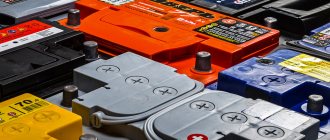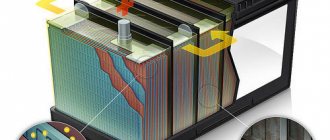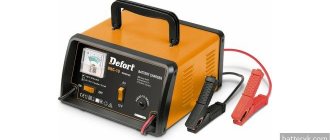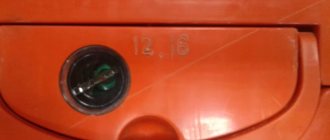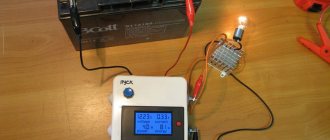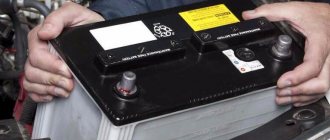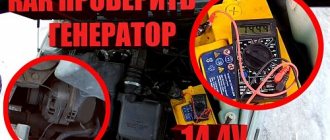Car batteries are designed to perform several basic functions. First of all, the battery is responsible for starting the engine starter and provides power to the entire “on-board system” of the car: the operation of headlights, alarms, and music. It also supports the generator under load. Therefore, the battery should always be the first object to which motorists should constantly pay their attention, carrying out timely battery maintenance.
Servicing a car battery with your own hands is a skill necessary for every owner, because the viability of the car depends on the battery. Proper and timely maintenance can significantly extend the life of any battery. And then you won’t find yourself in a situation where you need to look for a way to charge the battery without a charger somewhere on the highway.
General recommendations
Beginning motorists should understand that standard car batteries are not currently available in retail sales. They are all different: in the type of electrolyte, in appearance and in the duration of use. Once upon a time, cars from the Soviet era were equipped with standard batteries that could be fully serviced by literally disassembling them piece by piece. Jars with electrolyte were placed in a strong black ebonite case and filled with mastic.
Now, due to the fact that there are so many different manufacturers on the market, car batteries are not produced according to any specific standard. You should take care of them, being aware of some of their features, the essence of which is not so difficult to understand.
For example, if batteries cannot be topped up with distilled water, chargers that maintain voltage automatically should be used. If this is not done, then the battery can be “dead” ahead of time.
Since one of the reasonable goals of every car owner is to become a motorist who will service it himself, you need to learn to carefully and in detail study the instructions that come with the battery model that is installed in the car. If there is a shortage of electrolyte, the electrolyte should be topped up exclusively with distilled water. Under no circumstances should the electrolyte itself be poured into the battery.
Preventing battery problems
Any diagnostic measures will become useless if the battery is not used correctly. On the contrary, by observing preventive measures, you can increase the service life of the battery and the quality of its work. What should every motorist know?
- To charge a maintenance-free battery, it is better to use a charger with automatic voltage regulation.
- If the electrolyte level decreases, it is necessary to restore the original value using distilled water.
- About once a month you need to inspect and clean the battery terminals.
- Before the onset of frost, it is advisable to measure the voltage supplied by the battery. Already at a temperature of -10 0C, the capacity can decrease by 20%, and at a temperature of -30 0C - up to 50%.
- Check the leakage current periodically to avoid a situation in which the battery suddenly runs out.
When charging, do not increase the current - it should be no more than 10% of the battery capacity declared by the manufacturer. Compliance with these rules for operating a car power supply, according to reviews from auto electricians, allows you to extend the service life of the device by 1-1.5 years.
Routine care
Car battery care should be carried out regularly, taking into account the intensity of use of the car and the conditions it encounters during the journey. Thus, the external condition of the battery should be checked as often as possible if the motorist is in poor or extreme road conditions : inspect the place in the car where the battery is installed, in order to prevent serious damage to the case and electrolyte leakage, which is possible during shaking or collision with another object. By the way, this is the main reason why battery terminals oxidize. It is also necessary to check whether the fastening has become loose.
Simple regular inspections can be carried out without removing the battery from the vehicle. But if the battery needs to be charged, it should be removed from the car. The case is carefully inspected so as not to miss a possible electrolyte leak. The drainage holes are checked and if they are dirty, they should be cleaned. In the same way, all external battery openings that can be seen on the outside of the batteries should be cleaned regularly.
If an electrolyte leaks, it must be neutralized using ordinary soda: as is known, an alkaline solution neutralizes the effect of acid . The terminals must be lubricated and cleaned with the same soda solution and the voltage level on them must be checked from time to time when the car engine is running. Normally, the voltage in a charged car battery should be between 12 and 14.5 V.
In winter and after the cold season, more careful maintenance of batteries should be carried out. Carrying out regular technical inspection of the battery without removing it from the car is acceptable. But, nevertheless, it is very advisable to remove the battery more often when servicing it, since you can inspect the place where it is installed.
For example, when electrolyte boils away at high temperatures, it often flows into different parts of the machine, and the acid can corrode its interior. The area under the battery needs to be washed, cleaned, lubricated with a rust converter, or even painted.
Cleaning Oxidized Terminals
A very important point, especially if the battery has liquid electrolyte. When starting the engine, the battery delivers hundreds of amperes of current. In this mode, the electrolyte “boils” - the water included in its composition decomposes into hydrogen and oxygen. In serviced batteries, gases escape through holes in the plugs. In maintenance-free ones, they are partially restored in special labyrinths provided in the battery cover, and partially exit through specially provided valves.
Oxygen and hydrogen themselves are harmless, but they are saturated with sulfuric acid vapor, which settles on the battery terminals. As a result, the tips and terminals of the battery oxidize over time, and the contact between them deteriorates. If special measures are not taken regularly, this can look very disastrous. Poor contact means difficult starting, constant undercharging and, as a result, battery failure.
Expert opinion
Alexey Bartosh
Specialist in repair and maintenance of electrical equipment and industrial electronics.
Ask a Question
Important! Very often you can hear the opinion that oxidation of the terminals is a sign of improper operation of the battery. This is not true. Oxidation occurs in any case. Another question is how quickly and intensely this happens. If you have to clean the terminals every month, then yes, it’s worth checking the charging mode and battery condition.
What should we do if the tips and terminals of our battery are oxidized and covered with “frost”? The obvious answer is to get them in order. Moreover, you can do this yourself, without resorting to the help of a specialist. In general terms it will look like this:
- Remove the lugs from the terminals.
- We thoroughly wash both of them with a strong solution of baking soda in water. This will help neutralize the acid.
- Using a wire brush or sandpaper, clean the tips and terminals until they shine.
- Thickly coat the terminals with any thick lubricant (salidol, cyatim, technical petroleum jelly, etc.).
- We install the tips in place and once again coat everything, including the tips, with thick lubricant.
If you want to get more detailed information about cleaning battery terminals, then read the article “How and with what to clean battery terminals from oxidation.”
How to check electrolyte density
Experienced motorists have long come up with their own classification of batteries, especially highlighting the “low-maintenance” battery with open access to banks. In this case, it is possible to check the electrolyte level in the jar, add water and charge it. By the way, if the battery boils when charging at the very beginning of the process, most likely the electrolyte level was initially too low.
If there are no holes in the battery at all, then it is completely devoid of maintenance, and such a car battery can only be helped by charging it periodically.
In the case when you have to deal with a “classic” example of a battery, and not with maintenance-free batteries, you will have to learn how to independently determine the density of the electrolyte inside the battery.
To determine the density of a battery, there is a special device called a hydrometer. The test is carried out at room temperature about +20°C. Before this, the battery is removed from the car and thoroughly cleaned so that during manipulations dirt and dust do not get inside it.
During the entire operating time of a car engine, as well as with temperature changes, there is a constant change in the level of electrolyte density. With a normal charge-discharge cycle, these changes are reversible. However, when the electrolyte boils or water evaporates, its density changes irreversibly, increasing if a similar process is repeated.
If the electrolyte density is higher than normal, this adversely affects the battery capacity and reduces its productive life. At low density, the voltage level becomes lower, making it difficult for the starter to operate and start the engine.
The electrolyte density is determined as follows. The tip of a hydrometer is individually immersed in each battery jar, and part of the liquid is removed from the jar with a rubber bulb. In the process of collecting liquid, you need to ensure that the float of the device floats up in the tube body and does not touch its walls. Readings are taken when the float stops moving, with reference to a special scale that is clearly visible along the liquid line.
The optimal electrolyte density is 1.25 -1.27 g/cm3, and the error between the readings in each jar should not be higher than 0.01.
Correction of the electrolyte density is carried out either with a correction fluid (at a lower density level - for example, in winter, to avoid the risk of freezing), or, if the density is high, the electrolyte is simply diluted with distilled water.
After this, the battery is charged with a low current of 1.5-2 A. Read about how much to charge the battery here →
Maintenance methods and frequency
Periodic maintenance can be divided into 2 groups of procedures that are carried out in relation to the battery:
- visual inspection, assessment of condition by external signs;
- diagnostics;
- maintenance, service operations.
In the first case, it is enough to simply look at the battery, make sure the body is intact, check for cracks, signs of leakage, oxidation of contacts, etc.
Next, more serious work is carried out.
Correct diagnostics of a car battery involves the following activities:
- checking the voltage when the circuit is open, that is, when the battery is not connected to the car;
- assessment of operating parameters when starting the engine;
- checking the level and condition of the electrolyte.
All these procedures, including visual inspection, must be carried out at certain intervals, without waiting for obvious problems with the battery to appear.
Experienced motorists advise combining battery diagnostics with checking the oil level, washer fluid, tire pressure, etc. That is, this should become a habit for the car owner.
As for maintenance or service operations, these works include:
- periodic unscheduled charging by an external device;
- checking and changing the electrolyte density;
- testing using a load fork;
- checking current leakage;
- prevention of sulfation.
To deal with maintenance issues yourself, you need to acquire the appropriate set of tools and materials.
The main components are:
- multimeter;
- load fork;
- hydrometer;
- memory;
- electrolyte;
- distilled water.
In addition to a hydrometer, to check the density you will need a bulb and a transparent tube made of glass or plastic. Such devices can be purchased as a kit.
When working with batteries, strictly follow safety rules. Wear protective gloves and goggles. It is advisable to work in overalls.
The service includes a fairly large list of activities. Each of them requires a separate explanation and some recommendations.
Maintenance-free battery care
If the battery is maintenance-free, this does not mean that it does not require care and monitoring of its operation. Although maintenance of this type of battery is very simple, it must also be carried out regularly.
The housing of maintenance-free batteries is also carefully inspected for possible external damage and electrolyte leakage. The drainage holes are checked and if they are dirty they should be cleaned. In the same way, you should regularly clean all parts of a maintenance-free battery, remembering to remove the upper false covers and wipe them, if any.
Periodic battery training
There are several effective methods for training batteries. They are also used to restore batteries that have not been used for a long time. Long-term charging at low currents is carried out for batteries with low sulfation. To do this, connect the charge with a normal current until gases appear. Next, the procedure is interrupted for 30 minutes. After this, connect the charge, reducing the current value by 1%. Again break for 30 minutes. Repeat the entire cycle 3-4 times. Deep charging with low currents is used for batteries with old sulfation. The method is based on alternating short charging cycles with standard currents and long-term charging with low currents. Charging with cyclic currents is used to increase battery life. At the same time, they connect the charge with low currents, after which they begin to discharge the battery and connect the charge again. The constant voltage method is based on reducing the current. To do this, initially set the maximum possible charge strength, gradually reducing it to a minimum.
Practical advice for motorists
Sometimes the battery says that it is maintenance-free, but strangely enough, there is access to the banks. In this case, you can carefully add distilled water into the holes. Perhaps, by writing the word “maintenance free” on the battery case, the manufacturers expected that the amount of electrolyte would be enough for the entire service life of the battery. But this is not always the case. False covers, when unscrewed, may turn out to be real ones, so it is recommended to check them more carefully.
After charging the battery, the electrolyte should be allowed to cool slightly before taking its density readings, because hot electrolyte may give inaccurate readings.
In winter, when the temperature is especially low, you need to try to make the process of operating the starter and starting the engine as easy as possible. According to the rules, the starter should not operate for more than 15 seconds during startup. If you fail to start the car in the first attempt, you must take a 1- or better 2-minute pause and try starting again. It is also possible to “boost” the battery by turning on the high beam headlights for 10 seconds, and for a faster start, fully depress the clutch.
By following simple but necessary tips for car maintenance, you can increase their service life, and then you won’t have to send your car in for repairs often. Proper and regular care of not only the car, but also its battery will help the driver get maximum pleasure and benefit when operating one of the most important means of transportation.
Types of automotive power supplies
In this article we will talk about acid batteries, which are installed on most cars and motorcycles. Their design is extremely simple: lead plates are immersed in the compartments, acting as electrodes. The jars are filled with an electrolyte solution, as a result of which chemical and physical reactions occur between it and the plates, resulting in the formation of an electric current.
Conventionally, lead-acid batteries can be divided into three types, each of which differs in some maintenance nuances.
- Serviceable – currently rarely used. Operation requires compliance with the prescribed maintenance regulations and some knowledge of electrical engineering.
- Maintenance-free or "maintenance-free". Condition monitoring is minimal, and virtually no maintenance work is carried out.
- Low maintenance. They are an intermediate link between the first two types. Current work requires monitoring the electrolyte level and its density.
Innovative batteries - gel or AGM, require a different approach to maintenance, therefore they will not be considered in this article.
Low level - why it’s dangerous
It is dangerous for many reasons, I will try to explain it simply and quickly:
- If the level drops, it means the water is evaporating. The density of sulfuric acid increases (since it does not go anywhere). This has a very negative effect on the plates themselves; they simply begin to deteriorate faster.
- If the acid concentration is high, this can lead to an accelerated sulfation process of the plates
- The upper part of the plates is exposed - and this also negatively affects them when charging. They simply warm up and can crumble.
- If there is not enough electrolyte (the plates are exposed), the battery capacity drops accordingly, meaning you simply won’t start the car.
From my own experience, I will say that batteries with bare plates do not last long; as a rule, they crumble or become sulfated within 3 to 6 months of use. Therefore, it is very important to add liquid to the required values!
Right choice
The key to trouble-free operation of the battery is the correct choice of battery. Care must be taken to ensure that the capacity and rated starting current are fully consistent with the characteristics of the vehicle. The battery case must not have mechanical damage ; calcium deposits on the terminals are not allowed.
It is also not recommended to save money and purchase batteries on the market, since it will be impossible to obtain the necessary guarantee there. It is best to buy batteries in specialized stores, where the car owner will be completely confident in the originality of a particular battery model and will receive the necessary quality guarantee for operation.
Batteries today are sold already fully charged, so after purchase the battery will not require any additional charging. But if the voltage of a new battery is below 12 V, this may indicate a defect and the presence of any problems with the battery. You should avoid purchasing a battery with a low initial charge.
It would be useful to additionally purchase a starting charger. Preference should be given to pulse models, which allow you not only to quickly charge the battery, but also provide fine voltage adjustment, allowing you to safely recharge the battery. In the future, such a device will guarantee trouble-free operation of the battery and the entire car.
Video
We invite you to watch a video about proper maintenance of car batteries.
The battery is practically the only component of the equipment of any car that requires periodic maintenance and diagnostics.
A considerable number of car owners often neglect the fact that the battery needs to be looked after. But in vain.
In general, work carried out on a battery cannot be called maintenance (in the literal sense of the word). More correctly, this process should be called prevention.
What should you add inside?
So, let's move on to the most interesting part. BUT first, a little reminder, many people mistakenly think that you need to add ready-made electrolyte inside , which is sold in automotive or specialty stores. BUT THIS IS NOT SO!
As I already said above, it is water that evaporates from the cans, and it is water that needs to be added to the cans, BUT NOT ELECTROLYTE!
Once again I want to repeat to everyone, it is the aqueous solution that evaporates, but not the acid! If you add electrochemical fluid to the level, then you will raise the density to a high level, say 1.32 - 1.35 g/cm3, the plates from such a concentration wear out much faster, and sulfates are also formed!
Therefore, only distilled water, and only a certain level.
